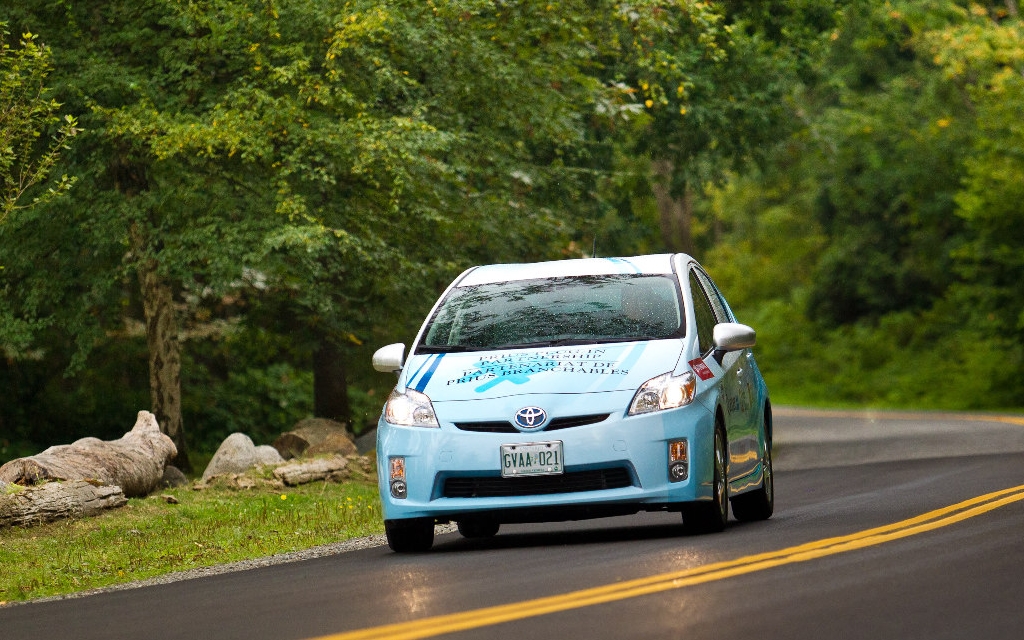2013 Toyota Prius Plug-in: Step two

| Strong points |
|
|---|---|
| Weak points |
|
“Render unto Caesar that which is Caesar’s.” Toyota was not only a pioneer in the technological development of the hybrid engine, but it also produces more hybrid vehicles than any other company. Now in the second phase of developing this technology, Toyota is about to release a plug-in version, which recharges the batteries that supply this system’s electric motor. On the first hybrid version, the battery capacity was barely enough to go a few metres in 100% electric mode. On the plug-in, you can recharge the batteries before hitting the road. The batteries are bigger and more powerful but more cumbersome than those in the “normal” model. That means that you can go about 15 or 20 km before the gas engine is needed.
Sales of this model will begin in 2012, but when I was offered the chance to drive a preproduction version, I jumped at the opportunity!
Very few clues
My test car didn’t exactly fly under the radar. Its spectacularly decorated body announced to the world that this was a plug-in hybrid car. But without these decorations, it would have been impossible to tell it apart from the regular hybrid version, not if you were looking at the right side of the car, anyway. On the other hand, on the front left fender, there’s a trapdoor that leads to the plug used for recharging the lithium-ion batteries. Another difference is in the baggage hold, where the floor is a little higher to make room for the batteries. Finally, the final clue that this is indeed a unique car is a signal light on the left side of the dashboard that indicates if the car is charging or not.
Recharging at a 120-volt outlet is disarmingly simple. All you need is an extension cord and an electrical outlet. Even then, at the test drive, the car’s cable was often enough to connect to the outlet. And, according to Toyota, a mere three hours is all it takes to recharge completely.
As for the rest, the Prius Plug-In features the same drivetrain as the standard version, namely a 1.8-litre four-cylinder Atkinson cycle gas engine coupled with a CVT automatic transmission. It is also paired with an electric motor that brings the total power to 134 horses.
The same ride
Whether you drive the plug-in or the ordinary version, the ride is the same. Nevertheless, I must say that my test car had made the rounds as a demonstration vehicle over the last year and had almost 30,000 km on the odometer. In other words, it hadn’t been coddled leading up to my test drive, so the suspension components had seen better days. Considering that it was winter as well and that the roads were in poor condition, it’s no surprise that I was tossed around a bit inside this Prius.
But when it comes to handling, accelerations, pick-up and braking, there’s no difference between the plug-in and the current version. Note, however, that this was the first time that I’ve driven a car whose handling actually improved because of its snow tires. In summer, this Toyota comes with low-resistance tires that provide less-than-fantastic grip.
Not for the lazy
Once the lithium-ion batteries are totally charged, you can travel between 15 and 20 km in all-electric mode. To do this, of course, you have to recharge the batteries every day. In a way, that’s the problem with the plug-in Prius. Since I tested it in cold weather, it wasn’t always pleasant to go plug the car into a wall outlet. I did it religiously for a couple of days until freezing rain made the experience less agreeable. After that, laziness took over and I settled for driving in hybrid mode only. I’m convinced that people who buy this model will occasionally neglect the extension cord – unless they are hard-core environmentalists.
When I drove the car in extended electric mode and then subsequently in hybrid mode, the average fuel consumption was 3.8 L/100 km. On the other hand, in “lazy” mode, that figure rose to 4.7 L/100 km, which isn’t too bad either, considering the cold weather.
Turns out that this newcomer is a pretty interesting choice after all. Plug-in versions seem to be here to stay, provided the asking price isn’t excessive. In my opinion, there’s no doubt that a Prius V Plug-in would be a very attractive option.











